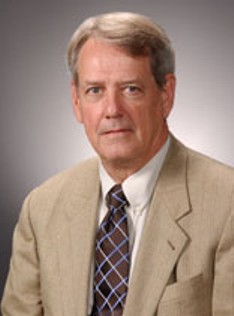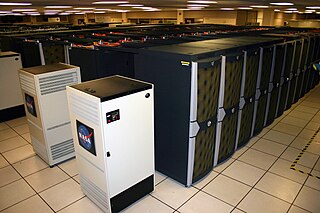
The USC Information Sciences Institute (ISI) is a component of the University of Southern California (USC) Viterbi School of Engineering, and specializes in research and development in information processing, computing, and communications technologies. It is located in Marina del Rey, California.

The Ames Research Center (ARC), also known as NASA Ames, is a major NASA research center at Moffett Federal Airfield in California's Silicon Valley. It was founded in 1939 as the second National Advisory Committee for Aeronautics (NACA) laboratory. That agency was dissolved and its assets and personnel transferred to the newly created National Aeronautics and Space Administration (NASA) on October 1, 1958. NASA Ames is named in honor of Joseph Sweetman Ames, a physicist and one of the founding members of NACA. At last estimate NASA Ames had over US$3 billion in capital equipment, 2,300 research personnel and a US$860 million annual budget.

The Goddard Space Flight Center (GSFC) is a major NASA space research laboratory located approximately 6.5 miles (10.5 km) northeast of Washington, D.C. in Greenbelt, Maryland, United States. Established on May 1, 1959 as NASA's first space flight center, GSFC employs about 10,000 civil servants and contractors. Named for American rocket propulsion pioneer Robert H. Goddard, it is one of ten major NASA field centers. GSFC is partially within the former Goddard census-designated place; it has a Greenbelt mailing address.

James Sacra Albus was an American engineer, Senior NIST Fellow and founder and former chief of the Intelligent Systems Division of the Manufacturing Engineering Laboratory at the National Institute of Standards and Technology (NIST).
Human-centered computing (HCC) studies the design, development, and deployment of mixed-initiative human-computer systems. It is emerged from the convergence of multiple disciplines that are concerned both with understanding human beings and with the design of computational artifacts. Human-centered computing is closely related to human-computer interaction and information science. Human-centered computing is usually concerned with systems and practices of technology use while human-computer interaction is more focused on ergonomics and the usability of computing artifacts and information science is focused on practices surrounding the collection, manipulation, and use of information.

The NASA Advanced Supercomputing (NAS) Division is located at NASA Ames Research Center, Moffett Field in the heart of Silicon Valley in Mountain View, California. It has been the major supercomputing and modeling and simulation resource for NASA missions in aerodynamics, space exploration, studies in weather patterns and ocean currents, and space shuttle and aircraft design and development for almost forty years.
The Lunar and Planetary Institute (LPI) is a scientific research institute dedicated to study of the solar system, its formation, evolution, and current state. The Institute is part of the Universities Space Research Association (USRA) and is supported by the Science Mission Directorate of the National Aeronautics and Space Administration (NASA). Located at 3600 Bay Area Boulevard in Houston, Texas, the LPI is an intellectual leader in lunar and planetary science. The Institute serves as a scientific forum attracting world-class visiting scientists, postdoctoral fellows, students, and resident experts; supports and serves the research community through newsletters, meetings, and other activities; collects and disseminates planetary data while facilitating the community's access to NASA astromaterials samples and facilities; engages and excites the public about space science; and invests in the development of future generations of scientists. The LPI sponsors and organizes several workshops and conferences throughout the year, including the Lunar and Planetary Science Conference (LPSC) held in March in the Houston area.
The Pittsburgh Supercomputing Center (PSC) is a high performance computing and networking center founded in 1986 and one of the original five NSF Supercomputing Centers. PSC is a joint effort of Carnegie Mellon University and the University of Pittsburgh in Pittsburgh, Pennsylvania, United States.

The Universities Space Research Association (USRA) was incorporated on March 12, 1969, in Washington, D.C. as a private, nonprofit corporation under the auspices of the National Academy of Sciences (NAS). Institutional membership in the association currently stands at 113 universities. All member institutions have graduate programs in space sciences or technology. Besides the 98 member institutions in the United States, there are two member institutions in Canada, four in Europe, two in Israel, one in Australia and one in New Zealand, one in Hong Kong, two in Korea and two in the United Kingdom.
Barney Pell is an American entrepreneur, angel investor and computer scientist. He was co-founder and CEO of Powerset, a pioneering natural language search startup, search strategist and architect for Microsoft's Bing search engine, a pioneer in the field of general game playing in artificial intelligence, and the architect of the first intelligent agent to fly onboard and control a spacecraft. He was co-founder, Vice Chairman and Chief Strategy Officer of Moon Express; co-founder and chairman of LocoMobi; and Associate Founder of Singularity University.

Simon Peter Worden is formerly the Director of NASA's Ames Research Center (ARC) at Moffett Field, California, until his retirement on March 31, 2015. Prior to joining NASA, he held several positions in the United States Air Force and was research professor of astronomy at the University of Arizona, Tucson. He is a recognized expert on space issues – both civil and military. Worden has authored or co-authored more than 150 scientific papers in astrophysics, space sciences, and strategic studies. He served as a scientific co-investigator for two NASA space science missions, and received the NASA Outstanding Leadership Medal for the 1994 Clementine mission. He was named the 2009 Federal Laboratory Consortium Laboratory Director of the Year.

NASA Research Park is a research facility under the auspices of NASA located in San Jose, California. It is focused on fostering collaboration among government entities and academic institutions.

The Istituto Italiano di Tecnologia (IIT) (in English: Italian Institute of Technology) is a scientific research centre based in Genoa (Italy, EU). Its main goal is the advancement of science, in Italy and worldwide, through projects and discoveries oriented to applications and technology. Some account IIT as the best Italian scientific research centre.

Pleiades is a petascale supercomputer housed at the NASA Advanced Supercomputing (NAS) facility at NASA's Ames Research Center located at Moffett Field near Mountain View, California. It is maintained by NASA and partners Hewlett Packard Enterprise and Intel.
D-Wave Two is the second commercially available quantum computer, and the successor to the first commercially available quantum computer, D-Wave One. Both computers were developed by Canadian company D-Wave Systems. The computers are not general purpose, but rather are designed for quantum annealing. Specifically, the computers are designed to use quantum annealing to solve a single type of problem known as quadratic unconstrained binary optimization. As of 2015, it was still debated whether large-scale entanglement takes place in D-Wave Two, and whether current or future generations of D-Wave computers will have any advantage over classical computers.

The International Space Orchestra (ISO) is a team of space scientists from the NASA Ames Research Center, SETI Institute (Search for Extraterrestrial Intelligence), Singularity University, and the International Space University.
Marsha J. Berger is an American computer scientist. Her areas of research include numerical analysis, computational fluid dynamics, and high-performance parallel computing. She is a Silver Professor (emeritus) of Computer Science and Mathematics in the Courant Institute of Mathematical Sciences of New York University. She is Group Leader of Modeling and Simulation in the Center for Computational Mathematics at the Flatiron Institute.

Guy André Boy is a French and American scientist and engineer, Fellow of the International Council on Systems Engineering (INCOSE), the Air and Space Academy, and the International Academy of Astronautics. He is FlexTech chair holder at CentraleSupélec and ESTIA Institute of Technology. He is also a visiting scholar at ISAE-SUPAERO. He was a university professor and dean (2015–2017) at Florida Institute of Technology (FIT), where he created the Human-Centered Design Institute in 2010. He was senior research scientist at Florida Institute for Human and Machine Cognition (IHMC). He was Chief Scientist for Human-Centered Design at NASA Kennedy Space Center (KSC) from 2010 to 2016. He is known for his work on intelligent assistance, cognitive function analysis, human-centered design (HCD), orchestration of life-critical systems, tangible interactive systems, and human systems integration.
The University of Maryland, Baltimore County (UMBC) features a variety of research centers and institutes both based on the campus and affiliated with other academic institutions. These centers and institutes listed below seek out to expand their research, educate, and promote partnerships between the university and the Baltimore-Washington Metropolitan Area and beyond.
Yvonne Jean Pendleton is an American astrophysicist and is currently the Chief Scientist of NASA’s Solar System Exploration Research Virtual Institute (SSERVI) at Ames Research Center in Mountain View, California. Pendleton earned degrees from the Georgia Institute of Technology, Stanford University, and the University of California at Santa Cruz and was hired by NASA as a civil servant in 1979. She served as a research scientist in the Space Science and Astrobiology Division at NASA Ames Research Center (ARC) until 2007, including as Division Chief from 2006-7. In 2007 she was promoted to the Senior Executive Service, the highest level of civil service within the Federal government, and throughout her career has served in high-level leadership positions at both NASA's ARC and Headquarters. Her scientific research has investigated the origin and evolution of organic material in our galaxy and is currently focused on the composition of the solar nebula from which our Solar System formed. She is an elected fellow of the California Academy of Sciences and Asteroid 7165. Pendleton was named by the International Astronomical Union in honor of her research contributions.












